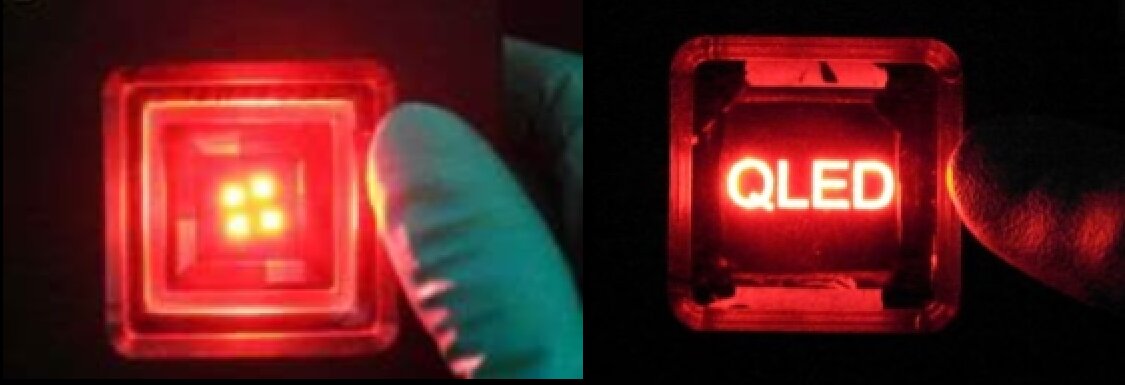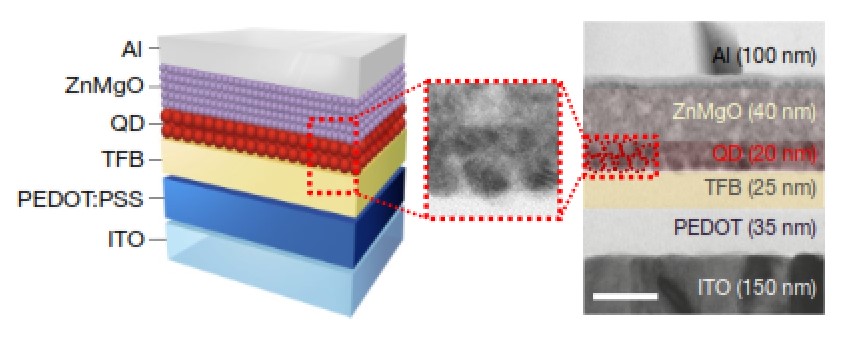If you follow my articles, or advanced display technology in general, you know that electroluminescent QLED (EL-QLED) is poised to become a game changing direct view display technology for a multitude of reasons – brightness, viewing angle, cost, efficiency, color gamut – the list goes on. But most of the development of this technology in the past 20 years has been based on cadmium-containing Quantum Dots (QDs).

Most people in this field agree that if it is going to be a viable consumer technology, we must get rid of (or dramatically reduce) the Cd in these materials. The QD community has put a lot of effort into achieving this for down-conversion (QD film, QDEF) technology, and the current state of the art InP QDs are pretty remarkable – quantum yields >90% and peak width (FWHM) of ~35 nm. And so continues the march with Cd-free EL-QLED.
Kudos to Display Daily’s trusty editor for finding this article about Samsung’s recent EL-QLED development before I did. My cursory review of the article showed nothing novel about the QD materials and methods being used (and I stand by that statement). However, the results of the article are quite impressive and a big step in the right direction for EL-QLED.
 An efficient, bright QLED with reasonable stability and no Cd to speak of. Well done Samsung.
An efficient, bright QLED with reasonable stability and no Cd to speak of. Well done Samsung.
The article, published in Nature in November, highlights three main properties that were optimized using an InP/ZnSe/ZnS QD system. 1. The quantum yield of the QD itself (as measured in solution) was optimized to be 100% for the best QD system. 2. The device efficiency for the highest performing device was 21.4% efficient. This might not sound that high, but it’s nearly perfectly efficient when accounting for optical outcoupling losses expected in this type of device. 3. The best devices achieved up to 100,000 nit brightness, far more than is required for most display applications. Oh, and they did it with QDs that show an impressively narrow spectrum at 35 nm FWHM (full-width and half-max peak height).
 Samsung took a logical approach to designing three different QDs with optimized properties. The winner in this case was “QD-3R” with the thickest ZnSe shell layer and an overall diameter of ~10 nm.
Samsung took a logical approach to designing three different QDs with optimized properties. The winner in this case was “QD-3R” with the thickest ZnSe shell layer and an overall diameter of ~10 nm.
How did they do it? Basically, Samsung took a very scientific approach (surprise, surprise) using well-known methods and materials for making high-quality QDs and devices. Keep in mind they have been making InP QDs for a long time and make some of the best QDs in the business. They presumably have some nice facilities as well. A few technical highlights about how they did it that may be meaningful to those who know this field. Apologies if these details are too ‘in the weeds’ for some readers.
- They incorporated an in-situ HF etch (to remove oxide) into the synthesis itself before growing the shell on InP core resulting in higher photoluminescence quantum yield (unity for one of the QD types).
- They explored three different shell thicknesses to effectively reduce Fluorescence Resonant Energy Transfer (FRET) resulting in a highly efficient device of >20% EQE.
- High temperature (340 C) growth to induce pseudo-spherical QDs with high QY and excellent crystallinity (minimal defects).
- Ligand exchange to a shorter ligand to improve charge balance and film conductivity for a long-lasting device.
 Image of an EL-QLED device use by Samsung. Notice the active QD layer is only 20 nm (~2 monolayers) thick.
Image of an EL-QLED device use by Samsung. Notice the active QD layer is only 20 nm (~2 monolayers) thick.
Perhaps you have heard this before, but the property that is really holding back EL-QLEDs is lifetime (see my blog from earlier this year about EL-QLED progress which is now mostly out of date based on recent results). Cd-based red EL-QLEDs are arguably already there, but green and blue still lag behind considerably. And when discussing InP most people don’t even mention lifetime because it’s assumed to be very short. Samsung did a good job characterizing the lifetime of these devices under various brightness conditions, but they were sort of spread out in the paper, so I have summarized it here. Keep in mind some of these lifetimes are predicted based on accelerated testing (1M hrs = 114 years after all), and I have identified those data points with a *.
Table summarizing lifetime characteristics for the best QLED devices in Samsung’s 2019 Nature paper (units = hours, * = predicted)
|
Metric |
100 nits |
1,000 nits |
3,000 nits |
4,500 nits |
10,000 nits |
|
T95 |
615 |
– |
86 |
– |
10 |
|
T90 |
1,315 |
– |
179 |
~50 |
21 |
|
T75 |
– |
4,300 |
– |
200 |
– |
|
T50 |
1,000,000* |
16,348* |
– |
– |
– |
The article makes a big deal about achieving one-million-hour lifetime, and an impressive result it is. But we must keep in mind that this reported lifetime is for T50 (time to 50% luminance) at 100 nits brightness. Using more realistic metrics and conditions these devices are not commercial-ready and are still a far cry from their Cd-containing cousins.
TCL presented data at the QD Forum 2019 of CdSe-based red EL-QLEDs achieving a T95 of >4,000 hours at 1000 nits. This Samsung paper did not share a comparable data point but based on T95 at 100 nits (615 hr) and T95 at 3,000 nits (86 hr) we can assume that at 1,000 nits the Samsung InP device it is not yet comparable to the Cd-containing devices that TCL boasts. Of course, I am being quite picky here. The results shown by Samsung are very good. This paper represents a big step forward in the field of Cd-free EL-QLED, and I expect it is one that will hold the title of efficiency and lifetime for Cd-free EL-QLED some time. I can only assume Samsung has already surpassed this with internal testing that has not been published.
What else could you want? To answer my own question – more colors and longer lifetime! Red has always been the easiest nut to crack for EL-QLED, but we need to have green and blue to make a display! There is still room for improvement for lifetime as well. In order to be viable for a consumer TV, these devices will need to last 30k hours at 500-1000 nits, not 100 nits. And a more appropriate spec would be T95, not T50 as Samsung reported for the 1 million hour predicted lifetime. This will require continued optimization of the materials and device stack design.
An impressive result, Samsung. Keep up the good work. Maybe you can show us some green and blue devices with the same performance? Longer lifetime would be nice too. I’ll put in on my Christmas list this year. (PP)
Peter Palomaki is the owner and chief scientist at Palomaki Consulting, a firm specializing in helping companies solve big problems at the nanoscale. His utilizes his expertise in quantum dots and materials chemistry to solve challenging problems with clients large and small.

